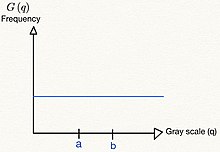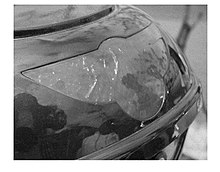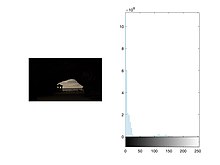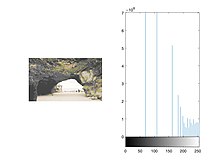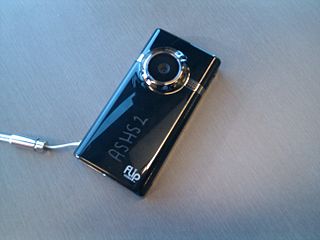Digital image transformations
Filtering
Digital filters are used to blur and sharpen digital images. Filtering can be performed by:
- convolution with specifically designed kernels (filter array) in the spatial domain [37]
- masking specific frequency regions in the frequency (Fourier) domain
The following examples show both methods: [38]
| Filter type | Kernel or mask | Example |
|---|---|---|
| Original Image | 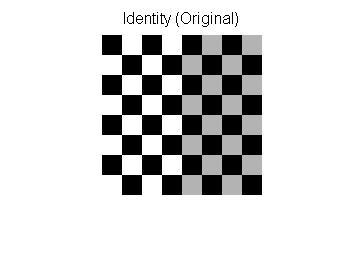 | |
| Spatial Lowpass |  | |
| Spatial Highpass |  | |
| Fourier Representation | Pseudo-code: image = checkerboard F = Fourier Transform of image Show Image: log(1+Absolute Value(F)) |  |
| Fourier Lowpass |  | 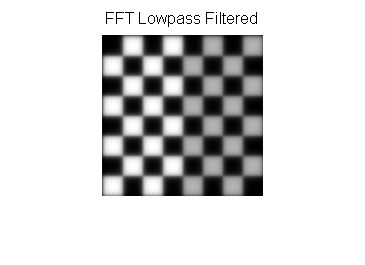 |
| Fourier Highpass |  |  |
Image padding in Fourier domain filtering
Images are typically padded before being transformed to the Fourier space, the highpass filtered images below illustrate the consequences of different padding techniques:
| Zero padded | Repeated edge padded |
|---|---|
 |  |
Notice that the highpass filter shows extra edges when zero padded compared to the repeated edge padding.
Filtering code examples
MATLAB example for spatial domain highpass filtering.
img=checkerboard(20);% generate checkerboard% ************************** SPATIAL DOMAIN ***************************klaplace=[0-10;-15-1;0-10];% Laplacian filter kernelX=conv2(img,klaplace);% convolve test img with% 3x3 Laplacian kernelfigure()imshow(X,[])% show Laplacian filteredtitle('Laplacian Edge Detection')Affine transformations
Affine transformations enable basic image transformations including scale, rotate, translate, mirror and shear as is shown in the following examples: [38]
| Transformation Name | Affine Matrix | Example |
|---|---|---|
| Identity |  | |
| Reflection |  | |
| Scale |  | |
| Rotate |  where θ = π/6 =30° where θ = π/6 =30° | |
| Shear |  | |
To apply the affine matrix to an image, the image is converted to matrix in which each entry corresponds to the pixel intensity at that location. Then each pixel's location can be represented as a vector indicating the coordinates of that pixel in the image, [x, y], where x and y are the row and column of a pixel in the image matrix. This allows the coordinate to be multiplied by an affine-transformation matrix, which gives the position that the pixel value will be copied to in the output image.
However, to allow transformations that require translation transformations, 3 dimensional homogeneous coordinates are needed. The third dimension is usually set to a non-zero constant, usually 1, so that the new coordinate is [x, y, 1]. This allows the coordinate vector to be multiplied by a 3 by 3 matrix, enabling translation shifts. So the third dimension, which is the constant 1, allows translation.
Because matrix multiplication is associative, multiple affine transformations can be combined into a single affine transformation by multiplying the matrix of each individual transformation in the order that the transformations are done. This results in a single matrix that, when applied to a point vector, gives the same result as all the individual transformations performed on the vector [x, y, 1] in sequence. Thus a sequence of affine transformation matrices can be reduced to a single affine transformation matrix.
For example, 2 dimensional coordinates only allow rotation about the origin (0, 0). But 3 dimensional homogeneous coordinates can be used to first translate any point to (0, 0), then perform the rotation, and lastly translate the origin (0, 0) back to the original point (the opposite of the first translation). These 3 affine transformations can be combined into a single matrix, thus allowing rotation around any point in the image. [39]
Image denoising with Morphology
Mathematical morphology is suitable for denoising images. Structuring element are important in Mathematical morphology.
The following examples are about Structuring elements. The denoise function, image as I, and structuring element as B are shown as below and table.
e.g.
Define Dilation(I, B)(i,j) = . Let Dilation(I,B) = D(I,B)
D(I', B)(1,1) =
Define Erosion(I, B)(i,j) = . Let Erosion(I,B) = E(I,B)
E(I', B)(1,1) =
After dilation After erosion
An opening method is just simply erosion first, and then dilation while the closing method is vice versa. In reality, the D(I,B) and E(I,B) can implemented by Convolution
| Structuring element | Mask | Code | Example |
|---|---|---|---|
| Original Image | None | Use Matlab to read Original image original=imread('scene.jpg');image=rgb2gray(original);[r,c,channel]=size(image);se=logical([111;111;111]);[p,q]=size(se);halfH=floor(p/2);halfW=floor(q/2);time=3;% denoising 3 times with all method | 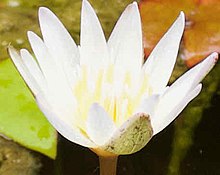 |
| Dilation | Use Matlab to dilation imwrite(image,"scene_dil.jpg")extractmax=zeros(size(image),class(image));fori=1:timedil_image=imread('scene_dil.jpg');forcol=(halfW+1):(c-halfW)forrow=(halfH+1):(r-halfH)dpointD=row-halfH;dpointU=row+halfH;dpointL=col-halfW;dpointR=col+halfW;dneighbor=dil_image(dpointD:dpointU,dpointL:dpointR);filter=dneighbor(se);extractmax(row,col)=max(filter);endendimwrite(extractmax,"scene_dil.jpg");end |  | |
| Erosion | Use Matlab to erosion imwrite(image,'scene_ero.jpg');extractmin=zeros(size(image),class(image));fori=1:timeero_image=imread('scene_ero.jpg');forcol=(halfW+1):(c-halfW)forrow=(halfH+1):(r-halfH)pointDown=row-halfH;pointUp=row+halfH;pointLeft=col-halfW;pointRight=col+halfW;neighbor=ero_image(pointDown:pointUp,pointLeft:pointRight);filter=neighbor(se);extractmin(row,col)=min(filter);endendimwrite(extractmin,"scene_ero.jpg");end | 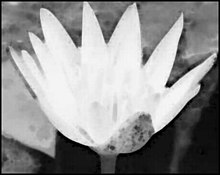 | |
| Opening | Use Matlab to Opening imwrite(extractmin,"scene_opening.jpg")extractopen=zeros(size(image),class(image));fori=1:timedil_image=imread('scene_opening.jpg');forcol=(halfW+1):(c-halfW)forrow=(halfH+1):(r-halfH)dpointD=row-halfH;dpointU=row+halfH;dpointL=col-halfW;dpointR=col+halfW;dneighbor=dil_image(dpointD:dpointU,dpointL:dpointR);filter=dneighbor(se);extractopen(row,col)=max(filter);endendimwrite(extractopen,"scene_opening.jpg");end |  | |
| Closing | Use Matlab to Closing imwrite(extractmax,"scene_closing.jpg")extractclose=zeros(size(image),class(image));fori=1:timeero_image=imread('scene_closing.jpg');forcol=(halfW+1):(c-halfW)forrow=(halfH+1):(r-halfH)dpointD=row-halfH;dpointU=row+halfH;dpointL=col-halfW;dpointR=col+halfW;dneighbor=ero_image(dpointD:dpointU,dpointL:dpointR);filter=dneighbor(se);extractclose(row,col)=min(filter);endendimwrite(extractclose,"scene_closing.jpg");end | 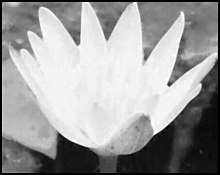 | |






















